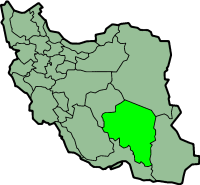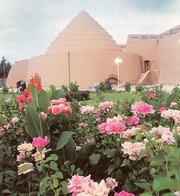Kerman Province
|
|
Shazdeh.jpg
| Contents |
Introduction
Kerman is one of the 30 provinces of Iran. It is in the south-east of the country. Its center is Kerman. The province of Kerman is the third largest in Iran, 181,714 km². The population of the province is about 2 million. The main townships of Kerman province are: Baft, Bardseer, Bam, Jiroft, Rafsanjan, Zarand, Sirjan, Shahr-e-Babak, Kerman, Mahan and Kahnooj.
In the year 1996, 52.9% of Kerman's population lived in urban areas, and 46% in the rural vicinities, the remaining 1.1% accounted as non residents. The city of Kerman (population: 400,000) embraces about 80% of the urban population, being the most developed and largest cities of the province.
Geography
The altitudes and heights of the province are the continuation of the central mountain ranges of Iran. They extend from the volcanic folds beginning in Azarbaijan, and by branching out in the central plateau of Iran, terminate in Baluchestan. These mountain ranges have brought about vast plains in the province of Kerman. The Bashagard and Koohbanan Mountains are the highest in this region, and include peaks such as, Toghrol, Aljerd, Palvar, Sirach, Abareq and Tahrood. Other ranges that stretch out from Yazd to Kerman and Challeh-ye-Jazmoorian, include peaks like Medvar, Shahr-e-Babak, Kooh Panj, Chehel Tan, Lalezar, Hezarbahr, Aseman and others.
Most of the province is largely steppe or sandy desert, although there are some oases where dates, oranges (said to be the best in Iran), and pistachios are cultivated. The province is dependent on qanats (underground water channels) for its irrigation. In the central parts, Mount Hezar is the highest peak, 4465 meters above sea level.
The climate in the province varies in different regions. The north, northwest, and central areas experience a dry and moderate climate, whereas in the south and southeast, the weather is warm and relatively humid. The city of Kerman and the surrounding regions have a semi-moderate and dry climate, with a maximum and minimum temperature of 39.6° C, and -7° C respectively. The average temperature during the months of March - June has been recorded as 20° - 25° C. These months are the most suitable period for traveling and tourism.
History and culture
Mahan.jpg
The history of human settlements in the territory of Kerman dates back to the 4th millennium BC. This vicinity can be considered as one of the ancient regions of Iran, and with the passage of time, valuable historical vestiges have in turn amassed here. Jiroft is an example, where a previously unknown settlement dating back to around 2500BC has just been established by archeologists. Historical documents refer to Kerman as "Karmania," "Kermania" and "Zhermanya," which means bravery and combat. Geographers have recorded Kerman's ancient name as "Go'asheer" (Bardesheer). Suffice to say that Kerman is well in abundance of historical sites and landmarks, 283 in total, according to Iran's Cultural Heritage Organization.
Kerman today
Kerman is prone to natural disasters. A recent flood for example, un-earthed the archeological ancient city of Jiroft, located south of Kerman province. Arg-é Bam on the other hand, the world's largest adobe structure, was destroyed in an earthquake in december 2003. And on February 22, 2005, a major earthquake killed hundreds of residents in the town of Zarand and several nearby villages in north Kerman. For more information, please see 2005 Zarand earthquake.
In regards to natural attractions, this region has sites such as thermal and mineral springs, recreational areas, verdant spaces, altitudes and peaks, lakes, pools, protected areas and the special desert features for adventure seekers. Especially if coupled with tourism. Where else can one find ancient abandoned citadels such as Arg-é Bam or Rayen castle preserved two thousand years in a desert?
Kerman is where a large portion of Iran's auto industry is based. Sirjan, a specially designated economic zone, is considered a passage-way for transfer of imported commercial goods from the south (through the Persian Gulf). Arg e Jadid, is another specially designated economic zone of Iran, located in Kerman province.
Colleges and Universities
Kerman province contains the following universities:
Kerman.jpg
- Kerman University of Medical Sciences (http://www.kmu.ac.ir/)
- Rafsanjan University of Vali Asr (http://www.vru.ac.ir/)
- Shahid Bahonar University (http://www.uk.ac.ir/)
- Rafsanjan University of Medical Sciences (http://www.rums.ac.ir)
- Islamic Azad University of Baft (http://www.iau-baft.ac.ir/)
- Islamic Azad University of Zarand (http://www.iau-zarand.ac.ir/)
- Islamic Azad University of Kerman (http://www.iauk.ac.ir/)
- Islamic Azad University of Jiroft
- Islamic Azad University of Bam
- Islamic Azad University of Bardseer
- Kerman Khaje-Nasir Higher Education Center (http://www.kkhec.ac.ir)
External links
- Official website of Kerman Governorship (http://www.kermanprovince.ir/)
- Tourist information on Kerman (http://greetings.irna.com/eturism/kerman/kerman.htm)
- Noncommercial Guide to Kerman Rugs & Carpets (http://www.spongobongo.com/Perk1b.htm)
- Kerman Cultural Heritage Organization (http://www.kermanmiras.org/main.htm)
- Kerman Specially Designated Economic Zone (http://www.kdo.ir)
| Provinces of Iran | 
|
|---|---|
| Ardabil | Bushehr | Chahar Mahaal and Bakhtiari | East Azarbaijan | Isfahan | Fars | Guilan | Golestan | Hamadan | Hormozgan | Ilam | Kerman | Kermanshah | Khuzestan | Kohkiluyeh and Buyer Ahmad | Kurdistan | Lorestan | Markazi | Mazandaran | North Khorasan | Qazvin | Qom | Razavi Khorasan | Semnan | Sistan and Baluchistan | South Khorasan | Tehran | West Azarbaijan | Yazd | Zanjan | |


